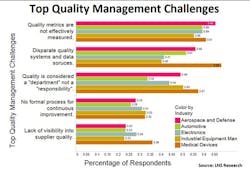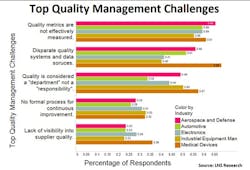Product lifecycle management for enterprise quality management
By implementing a product lifecycle management (PLM) system, companies both large and small benefit by simplifying and shortening each phase of the product development process. Due to their focus on product development and engineering, discrete manufacturers in the small-to-medium-sized space typically adopt a PLM system to support best-in-class engineering processes and to address challenges with continual new product introductions, shorter product lifecycles, and shrinking profit margins. Yet budget restraints usually leave quality processes left managed manually such as Excel spreadsheets. The result is tight engineering and design processes with costly quality issues that surface downstream.
To support the research that led to its report titled, “An Enterprise Approach to Quality for SME Discrete Manufacturers,” LNS Research performed a quality management survey and asked SME executives a number of questions regarding strategic objectives, as well as top challenges as each pertain to the quality management space. It is interesting to note in the charts below that executives in charge of quality for their businesses ranked “reducing the cost of quality” as a top objective (Figure 1).
Figure 1. Executives charged with quality at their businesses said reducing its cost was their top objective.
This correlates with the top challenges these same discrete manufacturing managers found: “quality metrics are not effectively measured” and “disparate quality systems and data sources.” This reveals that quality managers for SME discrete manufacturers need better tools to efficiently manage quality processes. The need is even greater in highly regulated industries such as aerospace and defense and medical device (Figure 2).
Figure 2. Quality managers need better tools to manage quality processes.
Extending PLM Into quality
According to LNS, many organizations are already using PLM to deliver quality management functionalities in the engineering and design stages. Examples may include the use of PLM to conduct risk management with tools such as failure mode and effects analysis (FMEA), using simulation tools to help companies implement changes, employing design for reliability (DfR) to tie upfront quality (pre-build) to the back-end (post-build) and enhance the overall quality process and change management capabilities that allow organizations to manage engineering and product data changes over time. Leveraging PLM to deliver enterprise-quality-management-system (EQMS) functionalities that streamline, standardize, and centralize quality process data and content takes these existing functionalities to new levels.
PLM was designed to manage product data throughout the product lifecycle. A PLM system is crucial during the design phase, where engineers need instant access to product data including specifications, engineering parameters, and documentation. PLM tracks and manages component data, BOMs, product documentation, engineering changes, and revisions, as well as compliance data, and centralizes all of this information for easy access by all team members. Extending PLM to encompass quality management allows manufacturers to link quality information to the product record all within a single database. This provides a mechanism to give engineers direct access to customer feedback to help make better design choices and gives quality visibility into the design process in order to catch costly issues before products are built.



